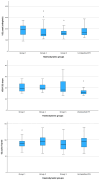Do Hemodynamic Definitions of Chronic Thromboembolic Pulmonary Hypertension Distinguish between Distinct Phenotypes of Chronic Thromboembolic Pulmonary Disease?
- PMID: 39405159
- PMCID: PMC7617186
- DOI: 10.1513/AnnalsATS.202405-524OC
Do Hemodynamic Definitions of Chronic Thromboembolic Pulmonary Hypertension Distinguish between Distinct Phenotypes of Chronic Thromboembolic Pulmonary Disease?
Abstract
Rationale: Chronic thromboembolic pulmonary disease (CTEPD) is defined by chronic organized thrombi in the pulmonary circulation without or with pulmonary hypertension. The current definition of chronic thromboembolic pulmonary hypertension (CTEPH) has adopted lower mean pulmonary arterial pressure (mPAP) and pulmonary vascular resistance (PVR) thresholds. Objectives: Our aim was to identify its impact on the characterization of patients with CTEPD. Methods: All consecutive patients with CTEPD referred for cardiopulmonary exercise testing (CPET) in a pulmonary hypertension center were divided into four groups on the basis of pulmonary hemodynamics: group A, mPAP ≤ 20 mm Hg; group B, mPAP > 20 mm Hg with PVR > 2 and ≤3 Wood units (WU); group C, mPAP > 20 mm Hg with PVR > 3 WU; and group D, mPAP > 20 mm Hg with PVR < 2 WU ("unclassified"). We compared CPET, computed tomography pulmonary angiography, and cardiac magnetic resonance imaging data across the groups. Results: There was mild aerobic capacity impairment, mild/moderate ventilatory inefficiency, and no significant cardiac limitation on CPET in all groups. However, patients in groups A and D had better ventilatory efficiency and less oxygen desaturation on exercise because of lower dead-space ventilation. There was no difference in chronic pulmonary embolus burden and distribution or resting right ventricular function among the groups. Seventeen patients were reclassified as having "CTEPH" on the basis of the current definition. No functional deterioration was noted within a median period of 13 months on repeat CPET. Conclusions: CTEPD patients with similar clot burden and right ventricular function without or with mild/moderate pulmonary hypertension displayed a similar pattern of cardiopulmonary limitation, except for ventilatory efficiency. The current definition of CTEPH may lead to the reclassification of CTEPH in a considerable number of patients.
Keywords: cardiopulmonary exercise test; chronic thromboembolic pulmonary disease; chronic thromboembolic pulmonary hypertension.
Figures


Comment in
-
The Complex Spectrum of Chronic Thromboembolic Pulmonary Disease and the Implications of Hemodynamic Reclassification.Ann Am Thorac Soc. 2025 Mar;22(3):324-326. doi: 10.1513/AnnalsATS.202412-1259ED. Ann Am Thorac Soc. 2025. PMID: 39835967 Free PMC article. No abstract available.
References
-
- Klok FA, van der Hulle T, den Exter PL, Lankeit M, Huisman MV, Konstantinides S. The post-PE syndrome: a new concept for chronic complications of pulmonary embolism. Blood Rev. 2014;28(6):221–226. - PubMed
-
- Moser KM, Bloor CM. Pulmonary vascular lesions occurring in patients with chronic major vessel thromboembolic pulmonary hypertension. Chest. 1993;103(3):685–692. - PubMed
-
- Ende-Verhaar YM, Cannegieter SC, Noordegraaf AV, et al. Incidence of chronic thromboembolic pulmonary hypertension after acute pulmonary embolism: a contemporary view of the published literature. Eur Respir J. 2017;49:1601792. - PubMed
-
- Galiè N, Chairperson E, Humbert M, et al. 2015 ESC/ERS Guidelines for the diagnosis and treatment of pulmonary hypertension. Eur Heart J. 2015;46:903–975. - PubMed
MeSH terms
Grants and funding
LinkOut - more resources
Full Text Sources
Medical
Research Materials

